
Azerbaijan is a country in the Caucasus region, situated at the juncture of Eastern Europe and West Asia. Three physical features dominate Azerbaijan: the Caspian Sea, whose shoreline forms a natural boundary to the east; the Greater Caucasus mountain range to the north; and the extensive flatlands at the country's center. About the size of Portugal or the US state of Maine, Azerbaijan has a total land area of approximately 86,600 km², less than 1% of the land area of the former Soviet Union. Of the three Transcaucasian states, Azerbaijan has the greatest land area. Special administrative subdivisions are the Nakhchivan Autonomous Republic, which is separated from the rest of Azerbaijan by a strip of Armenian territory, and the Nagorno-Karabakh Autonomous Region, entirely within Azerbaijan. The status of Nagorno-Karabakh is disputed by Armenia, but is internationally recognized as territory of Azerbaijan.

The transport in Azerbaijan involves air traffic, waterways and railroads. All transportation services in Azerbaijan except for oil and gas pipelines are regulated by the Ministry of Transportation of Azerbaijan Republic.

Ganja is Azerbaijan's third largest city, with a population of around 335,600. The city has been a historic and cultural center throughout most of its existence. It was the capital of the Ganja Khanate until 1804; after Qajar Iran ceded it to the Russian Empire following the Treaty of Gulistan in 1813, it became part of the administrative divisions of the Georgia Governorate, Georgia-Imeretia Governorate, Tiflis Governorate, and Elizavetpol Governorate. Following the dissolution of the Russian Empire and the Transcaucasian Democratic Federative Republic, it became a part of the Azerbaijan Democratic Republic, followed by Azerbaijan SSR, and, since 1991, the Republic of Azerbaijan.
The culture of Azerbaijan combines a diverse and heterogeneous set of elements which developed under the influence of Turkic, Iranic and Caucasian cultures. Azerbaijani culture includes its distinct cuisine, literature, folk art, and music.

Samad Vurgun was an Azerbaijani and Soviet poet, dramatist, public figure, first People's Artist of the Azerbaijan SSR (1943), academician of Azerbaijan National Academy of Sciences (1945), laureate of two Stalin Prizes of second degree, and member of the Communist Party of the Soviet Union from 1940.
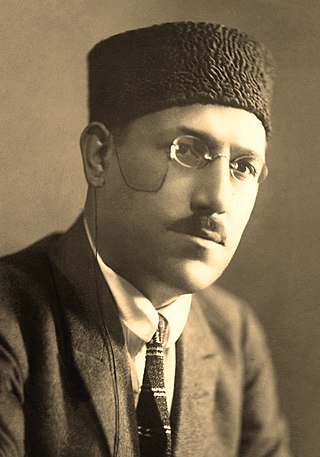
Huseyn Javid ,was born Huseyn Abdulla oghlu Rasizadeh, was a prominent Azerbaijani poet and playwright of the early 20th century. He was one of the founders of progressive romanticism movement in the contemporary Azerbaijani literature. He was exiled during the Stalin purges in the USSR.

The khanates of the Caucasus, also known as the Azerbaijani khanates, Persian khanates, or Iranian khanates, were various administrative units in the South Caucasus governed by a hereditary or appointed ruler under the official rule of Iran. The title of the ruler was khan, which was identical to the Ottoman rank of pasha. Following the assassination of Nader Shah in 1747, internal chaos erupted in Iran, particularly in the South Caucasus, where semi-autonomous khanates emerged as a result of the lack of a centralized government. The khans neither had territorial or religious unity, nor an ethnic/national identity. They were mostly interested in preserving their positions and income.

Aziz Mammad Karim oghlu Aliyev was an Azerbaijani, Dagestani, and Soviet politician, scientist, and member of the Supreme Soviet of the USSR. He was the father-in-law of Azerbaijan's President Heydar Aliyev, who married his daughter Zarifa Aliyeva, and maternal grandfather of Azerbaijan's current President Ilham Aliyev and brother of Shamama Alasgarova, who was a doctor.
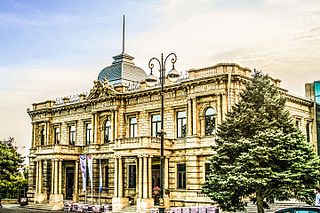
Azerbaijan National Museum of Art is the biggest art museum of Azerbaijan. It was founded in 1936 in Baku and in 1943 was named after Rustam Mustafayev, a prominent Azerbaijani scenic designer and theater artist. The museum consists of two 19th century buildings standing next to each other. The museum's total collection includes over 15,000 artworks. There are over 3,000 items in 60 rooms on permanent display. About 12,000 items are kept in storage. The museum changes the exhibits periodically so that more of these artworks can be displayed temporarily.
Surat Davud oghlu Huseynov was an Azerbaijani colonel who served as Prime Minister. He rose to prominence during the First Nagorno-Karabakh War, and his military career led, in 1993, to his rise to power, but he was later imprisoned.
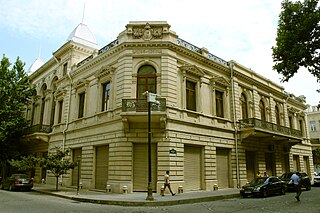
The National Museum of History of Azerbaijan is the largest museum in Azerbaijan. It is located in Baku, in the former residential house of Azerbaijani oil magnate and philanthropist Haji Zeynalabdin Taghiyev. The museum was founded in 1920, following the Russian takeover of Baku, and opened to visitors in 1921.

Rail transport in Azerbaijan is operated by the national state-owned railway company Azerbaijan Railways. The railway network consists of 2,918 km (1,813 mi), its gauge is 1,520 mm, 815 km (506 mi) are double track and 1,272 km (790 mi) are electrified at 3 kV (3,000 V) DC.

Tourism in Azerbaijan has been an important sector of the Azerbaijani economy since the 1990s. According to Azerbaijan's Center for Economic and Social Development, the country is in 39th place among 148 countries in tourism competitiveness indicators. The World Travel and Tourism Council reported that Azerbaijan is among the top ten countries with the greatest increase in visitor exports from 2010 to 2016. The country had the world's fastest-developing travel and tourism economy in 2017. To promote tourism, Azerbaijan sponsored Atlético Madrid jerseys reading "Azerbaijan – Land of Fire". In 2018, a new tourism brand and a slogan "take another look" were introduced.
Azerbaijani art is the art created by Azerbaijanis. They have created rich and distinctive art, a major part of which is applied art items. This form of art rooted in antiquity, is represented by a wide range of handicrafts, such as chasing (metalworking), jewellery-making, engraving, carving wood, stone and bone, carpet-making, lacing, pattern weaving and printing, and knitting and embroidery. Each of these decorative arts is evidence of the culture and the abilities of the Azerbaijan nation, and are very popular there. Many interesting facts pertaining to the development of arts and crafts in Azerbaijan were reported by merchants, travellers and diplomats who visited these places at different times.
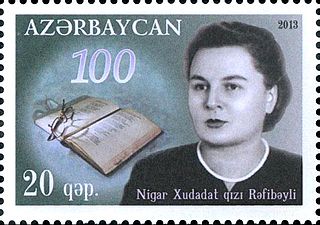
Nigar Khudadat qizi Rafibeyli was an Azerbaijani writer and the Chairman of the Writers' Union of Azerbaijan. She was the mother of Anar Rzayev, novel and short-story writer, and wife of famous writer and poet Rasul Rza.
Tofig Gasym oghlu Kocharli was a Soviet and Azerbaijani historian, former deputy to Supreme Soviet of Azerbaijan SSR, member of Azerbaijan National Academy of Sciences, most prominently for his work on the histories of Azerbaijani regions of Karabakh and Nakhchivan.

Aidan Salahova is an Azerbaijani and Russian artist, gallerist and public person. In 1992 she founded the Aidan Gallery in Moscow. Salahova's works can be found in many private and state collections including the State Tretyakov Gallery, the Moscow Museum of Modern Art, the Ekaterina Cultural Foundation, Francois Pinault Foundation, Teutloff Museum and the Boghossian Foundation; in private collections of I. Khalilov, Matan Uziel family collection, P-K. Broshe, T. Novikov, V. Nekrasov, V. Bondarenko and others. At the 2011 Venice Biennale, Salahova's name hit the headlines when her work was politically censored.
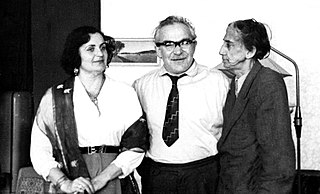
Maral Yusif gizi Rahmanzade also known as Maral Rahmanzade, was a Soviet, Azerbaijani graphic artist and visual artist. She was awarded the honorary title of People's Artist of Azerbaijan (1964), and recipient of the State Prize.


















